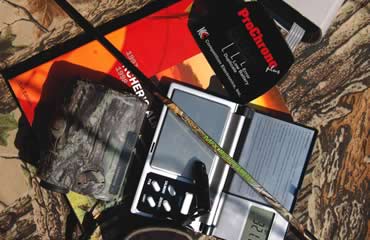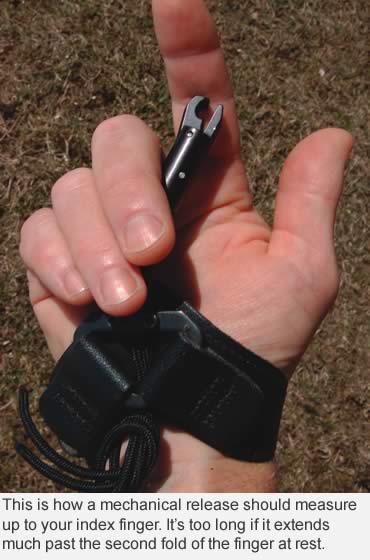Are bowhunters giving up accuracy to get more speed?
Fast computers. Speedy couriers. Express mail. Quickie lube jobs. Instant pudding. Seems whatever is fastest, we like it the “mostest.” America’s love affair with speed isn’t limited to everyday consumer goods. It spills over to leisure sports, and that certainly includes the game of bows ‘n’ arrows.
The faster a bow shoots, the more attention it seems to get. But how fast is fast, and is there a cost?
What is Fast Today?
While it’s true that the IBO ratings of flagship bows have increased in recent years (from 300.5 feet per second (fps) in 2004 to 305.2 fps in 2007), there hasn’t been a dramatic jump in bow performance since carbon became king back in the 1990s. Then, bowhunters in the know switched from aluminum to carbon shafts and watched arrow speeds jump 25 to 50 fps overnight. Today, a “speed bow” boasts an IBO rating over 340 fps.
Not long ago, archers had to choose between speed models and accuracy models. The former were fast but harsh-drawing and less forgiving. The latter were significantly slower but easier to maintain and more fun to shoot. Today, that kind of decision is absent in the flagship models of the top bow companies. I consider any bow with a 7-inch brace height and a 315-320 IBO rating to be a tremendous advancement in the world of archery. It’s a “cake-and-eat-it-too” proposition.
In spite of this, bowhunters are always lusting after more performance. And why not? More speed usually means more penetration and easier range estimation. Unfortunately, we tend to let bad advice drive us toward the extremes. Because speed always comes with a cost, I see way too many archers paying way too much in their quest for extra arrow velocity. The four most common errors are:
1) Shooting too much poundage. The quickest – and occasionally the easiest – way to pick up more speed is to pull more weight. Since speed is a function of stored energy, you can store more energy by pulling harder against cranked-down limbs.
2) Cheating on draw length (overbowed). Another way to generate more speed is by lengthening the power stroke, which is how far, measured in inches, the bowstring is pulled from an “at rest” position to a full-draw position. Until quite recently, about 90 percent of all bowhunters were guilty of overbowing; today it ranges between 35 and 50 percent.
3) Playing with fire (touchy arrows). Yet another way to boost arrow speed is to shoot ultralight arrows. While the goal is worthy – faster arrows exhibit flatter trajectories, thereby adding to the margin of error on range estimation – the cost can be steep. Lightweight arrows are less stable and are therefore more vulnerable to crosswinds and shooting imperfections.
4) Throwing gasoline on the fire (inefficient bows). Shooting a bow that doesn’t roll over until the last instant is more likely to increase speed than one that rolls over sooner in the power stroke. The former stores a lot of energy, but is that energy used efficiently? A good illustration comes from a recent conversation with a top bow manufacturer. He told me of a competitor’s bow that was supposed to be a “load” (industry lingo for a bow storing a lot of energy). “Well, it stored about 7 more foot-pounds [of energy] than our [flagship] model,” he said. “Yet it shot about 2 feet per second slower.”
Speed at a Reasonable Price
Speed is like honey: It can be a very sweet, but after a while it can turn your stomach. Fact is, you can only handle so much before you reach a point of diminishing returns. Every extra foot per second is going to cost something, so the goal is getting a good return on your investment. To do that, you must be honest as you search out your personal optimum speed equilibrium (POSE).
 Each person is blessed with a limited number of resources (physical strength, body configuration, hand-eye coordination) that must be harnessed and translated into three objectives: speed, accuracy and consistency. Here are legitimate ways to “buy” more speed without compromising on accuracy and consistency:
Each person is blessed with a limited number of resources (physical strength, body configuration, hand-eye coordination) that must be harnessed and translated into three objectives: speed, accuracy and consistency. Here are legitimate ways to “buy” more speed without compromising on accuracy and consistency:
1) Modify your peep setup. If you haven’t already done so, eliminate rubber tubing connected to your peep; it’s an automatic speed reduction of 10 to 15 fps. Many bows come with no-twist strings, and there are several aftermarket string companies that make them.
2) Clear up the clutter on your bowstring. Do not load up your string with unnecessary frills. The more weight you add to your bowstring – especially toward the middle – the more you slow it down. So get rid of brass nocksets, eliminator cushion buttons and electrical grommets and redundant servings. Replace them with a lark-knotted string loop (also called D-loop) that reveals no more than a 1/4-inch space between the end of the loop and the end of the nock. And avoid the temptation to add a nockset to position the string loop into place. Instead, serve it in at the top if you’re afraid it will slip (chances are it will seat into the serving of the bowstring).
Use aftermarket silencers discriminately. If you shoot a single-cam, you only need one string silencer (set very close to the cam). For dual-cam models, keep the upper string silencer as close as possible to the upper cam.
3) Consider a different mechanical release. One of the biggest mistakes – and the easiest to remedy – is failing to maximize your power stroke. Here’s a three-step formula: Start with a bow that fits you. Computing draw length is easy: divide your wingspan by 2.5. For example, my wingspan is 67.5 inches, which results in a 27-inch draw length.
Use a lower anchor point. It’s complicated, but it increases your margin of error on longer shots and allows you to use slightly heavier arrows. Choose a mechanical release that moves the nocking point closer to your anchor point. (The jaws of the release should be even with the second fold of the index finger. Index-release models that are flush with your index finger reduce draw length and, therefore, arrow velocity.
Different Strokes
As one who is vertically challenged, I’m constantly searching for ways to increase arrow velocity and penetration while maintaining accuracy and consistency. I’ve conducted many experiments to help find the proverbial happy medium.
 A good place to start is determining personal arrow weight. The IBO standard is 5 grains per inch (gpi), which is universally considered too light for hunting. Most experts believe that the best hunting weight is between 8 and 10 gpi. This means a completed arrow, for most bowhunters, should weigh between 350 and 450 grains.
A good place to start is determining personal arrow weight. The IBO standard is 5 grains per inch (gpi), which is universally considered too light for hunting. Most experts believe that the best hunting weight is between 8 and 10 gpi. This means a completed arrow, for most bowhunters, should weigh between 350 and 450 grains.
Back in the late 1990s, Easton published The Archers Almanac, which contained trajectory tables and arrow-velocity charts. After studying them for a long time, I concluded that my theory of a “lighter arrow is better” held some water, especially on moderate-size game such as whitetails. Larger-bodied game is another matter, generally requiring a heavier arrow shaft to negotiate tough bone, tendons, cartilage and hide. My bottom line is that there are a lot of ways to skin a whitetail – you can have a lot of fun at both ends of the 350- to 450-grain spectrum!
As an example, my setup (27 1/4-inch arrow length) allows me the luxury of going light or heavy. I’ve gotten excellent results from Carbon Express Maxima Hunters weighing 375 grains. But I can also transition seamlessly to a heavier arrow, such as the Beman MFX that weighs 410 grains. The results? For whitetails, the difference was negligible on double-lung shots. I achieved complete pass-throughs with bow weights at only 50 pounds. (I was very sick last fall, lost 25 pounds and 20 pounds of bow weight.) However, when faced with a quartering-forward shot that required penetrating the shoulder blade, I was impressed with the extra penetration of the Beman.
Now here’s where things start to get a little hairy. The Beman shaft, noted above, is a thin-diameter, thick-walled design; it’s about 17/64 inches in diameter compared to conventional shafts measuring closer to 20/64 inches. I believe, all factors being equal, the former produces optimum penetration, due to its physical properties (less resistance, quicker recovery, etc). Further, at distances out to 30 yards, arrow drop was nearly the same for both arrow weights. Point being, arrow weight isn’t the only factor relating to penetration.
Besides arrow weight, we must take into consideration the body characteristics of the archer. Shorter archers like me have a built-in handicap, along with a built-in advantage; ditto for taller archers. Briefly, short guys have a shorter power stroke, and taller guys have a longer power stroke. Shorter guys can shoot shorter, more maneuverable bows, and taller guys must generally shoot a little longer axel-to-axel model. Furthermore, shorter guys can usually shoot a bow with a shorter brace height, which means an increase in the power stroke and therefore some help in making up for lost energy in their challenged draw stroke.
You need to understand the “brace height” principle so you don’t end up mismatched to the wrong bow. Brace height is the distance from the throat of the bow grip to the bowstring, measured in inches. Brace height is the most common method for bow manufacturers to increase the speed rating of their bows. Speed bows of yesteryear typically measured about 6 inches or less; however, flagship models today usually end up at 7 to 7 1/2 inches. As a general rule, the taller you are, the more a longer brace height will improve your accuracy. This isn’t necessarily true for shorter archers who can shoot shorter brace-height bows (up to a point) without compromising accuracy. Why? It has to do with how long the arrow is on the bowstring as the bow is fired. An archer with a 30-inch draw has 30 inches of “time” to influence (positively or negatively) his shot, whereas an archer with a 27-inch draw only has 27 inches of “time” to influence his shot.
Two more tips: 1) Since tall archers don’t have to concern themselves with generating speed and penetration, they should concentrate on factors that build accuracy into their setup. 2) Since shorter archers are limited to the power they can generate, they should concentrate on factors that increase the power stroke and efficiency of their setups. Bottom line: Tall archers should shoot slightly heavier arrows with bows featuring modest brace heights; shorter archers should do the opposite.
In conclusion, speed is a double-edged sword. Because every shooter is different, you just need to know how much speed is enough, and how much is going to get you into trouble.
This article was published in the August 2007 edition of Buckmasters Whitetail Magazine. Join today to have Buckmasters delivered to your home.